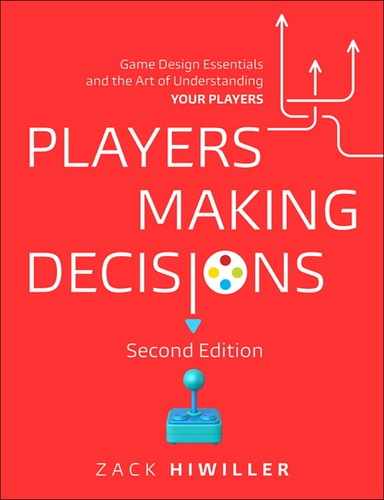Part 6: Human Behavior in Games
Reason shapes the future, but superstition infects the present.
—IAIN M. BANKS, THE STATE OF THE ART
When creating models for rational actors, it makes sense to examine an edge case: What would a perfect player do? And the larger your game is, the more it makes sense to look through the lens of the actions of a perfect player. A game with a few dozen players can get by with some loopholes. A game with millions of players is likely to have a few players who can ferret out all the possible exploits. Players are still finding exploits in the original Super Mario Bros. 30 years after it was published (http://kotaku.com/decades-later-someones-discovered-a-new-super-mario-br-1591884544).
If you assume all your players are perfect robots, your models for how players choose in your games become a whole lot easier, but the challenge of creating an entertaining and challenging game skyrockets. Luckily, you don’t have to face this problem. Humans are lazy, but they are massively complex decision makers.
One of the greatest tragedies in game education is that human psychology is not given the same emphasis as programming, art, and project management. Humans play your games and human behavior is delightfully difficult to predict. However, psychology has been asking of all humans the same questions that we game designers have been asking our players since the dawn of the field of psychology itself. How do we choose? Why do we choose what we do? How do we learn? What motivates us? What are our mental limitations? Answers and theories for all these questions have a huge role in game design.
Unfortunately, the answers are not straightforward. The best that you can do is ride on the coattails of powerful peer-reviewed research and try your hardest not to get duped by the charlatans that spout off-the-cuff statements about functional magnetic resonance imaging (fMRI) (www.theguardian.com/science/2012/may/27/brain-scans-flaws-vaughan-bell) and dopamine in pop-science books, articles, and flashy stage presentations. (For a better look at how complicated a relationship we have with dopamine, see Salamone, J. D., & Correa, M. [2012]. “The Mysterious Motivational Functions of Mesolimbic Dopamine.” Neuron, 76[3], 470–485.) Perhaps this is why game education seems to loathe including psychological findings; too often it’s difficult to separate the wheat from the chaff.
But why should game designers fear learning something only to have it later debunked by something else? We are constantly forced to relearn. When a new game engine or programming language revolutionizes (or simply adds upon) what we know about how we implement games, we do not give up on engines and programming altogether. Being a game designer means constant learning, but it also means constant unlearning. Don’t look for truths etched in stone.
Some futurists believe that the time is coming when technology will increase to the point at which the human brain can be emulated completely and consciousness itself can be transferred to artificial brains. Inventor Ray Kurzweil believes this can happen by 2045 (Grossman, L. [2011]. “2045: The Year Man Becomes Immortal.” Time, 177[7], 42–49). Other studies have projected the full stochastic mapping of the human brain to 2111 (Sandberg, A. and Bostrom, N. [2008]. “Whole Brain Emulation: A Roadmap, Technical Report” 2008–3. Tech. Rep., Future of Humanity Institute, Oxford University). It’s best to leave this debate to philosophers and speculative fiction authors. Until humanity can fully understand the nature of our own brains, we will have only marginally better and better best guesses as to how that lump of matter in our skulls really works. Once we master the human brain, games will become either entirely irrelevant or the focus of vastly increased leisure time.
In the meantime, let’s enjoy the puzzle that is human behavior.
